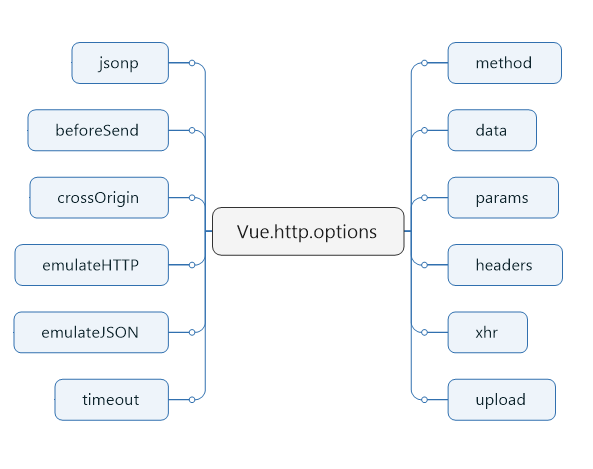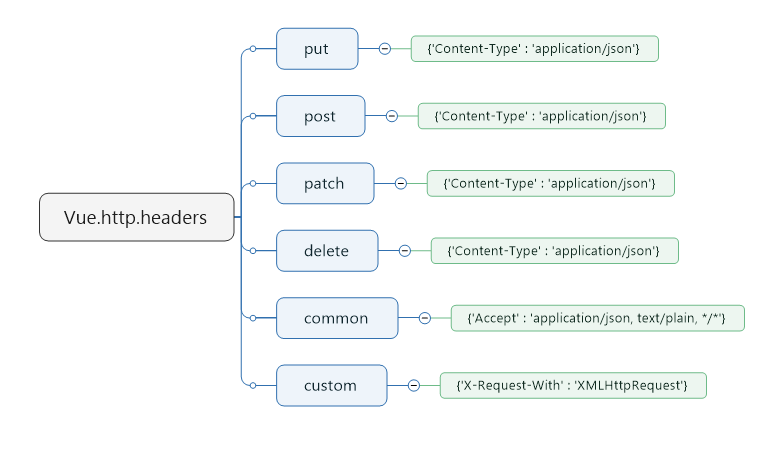首页 > 代码库 > Vue-resource 与服务器端通信
Vue-resource 与服务器端通信
与服务器端通信
Vue.js 可以构建一个完全不依赖后端服务的应用,同时也可以与服务端进行数据交互来同步界面的动态更新。Vue 本身并没有提供与服务端通信的接口,但是通过插件的形式实现了基于AJAX、JSONP 等技术的服务端通信。
vue-resource 是一个通过 XMLHttpRequest 或 JSONP 技术实现异步加载服务端数据的 Vue 插件,该插件提供了一般的 HTTP 请求接口和 RESTful 架构请求接口,并且提供了全局方法和 Vue 组件实例方法。
一般的 HTTP 请求接口按照调用的便捷程度又分为底层方法 和 便捷方法,便捷方法是对底层方法的封装。在 vue-resource 中我们可以全局配置,同时,它提供了数据获取各个阶段的钩子,使得我们可以对数据获取过程进行更好的控制。
vue-resource 插件提供的公开方法总览图:

vue-resource 安装及配置
1、安装
vue-resource 提供了 npm、bower、手动编译等安装方式,可以根据业务需要选择其中一种方式进行安装。
1-1、npm
如果项目基于 npm 包方式来开发,则可以使用 npm 来按照 vue 和 vue-resource,执行如下命令
$ npm i vue vue-resource --save-dev

然后在项目中引入 Vue.js 和 vue-resource,并且在 Vue.js 中注册 vue-resource 插件,代码如下:
// 引入 Vue.js 和 vue-resource var Vue = require(‘vue‘); var VueResource = require(‘vue-resource‘); // 注册 vue-resource 插件 // 注意,假如 Vue.js 已经在html 中直接引入,则不需要再执行此步骤 // 此时 vue-resource 会自动调用 Vue.use 方法来注册 Vue.use(VueResource); |
1-2、bower
当业务代码使用 bower 来管理时,可以使用 bower 安装到指定目录。假如该目录为 js/vendor,执行如下命令:
$ bower install vue-resource
在 HTML 中,在 vue 文件之后引入 vue-resource,代码如下:
<!-- 引入 Vue--> <script src="http://www.mamicode.com/js/vendor/vue.js"></script> <!-- 引入 vue-resource --> <script src="http://www.mamicode.com/js/vendor/vue-resource.js"></script> |
1-3、手动编译
当想尝试一些 Vue 中并未发布的新特性时,可以直接 clone 源码,手动构建实现。由于在未正式发布之前,有些特性可能被移除,所以不建议在生产环境中使用手动编译方式安装。
没有安装 git 工具的,可参照百度提供的步骤并解决安装过程中遇到的相关问题
http://jingyan.baidu.com/article/d2b1d1029065ba5c7e37d43e.html?st=2&os=0&bd_page_type=1&net_type=
执行命令如下:
$ git clone https://github.com/pagekit/vue-resource $ cd vue-resource $ npm install $ npm run build |


在C盘对应的目录下就生成了一系列的 vue-resource 文件

2、参数配置
vue-resource 将请求配置分为全局配置、组件实例配置和调用配置 三部分,这三部分的优先级依次增高,优先级高的配置会覆盖优先级低的配置。
全局配置默认参数,如图:

2-1、全局配置
Vue.http.options.root = ‘/root‘; Vue.http.headers.common[‘Authorization‘] = ‘Basic YXBpOnBhc3N3b3Jk‘;
2-2、组件实例配置
在实例化组件时,可以传入 http 选项来进行配置
new Vue({
http: {
root: ‘/root‘,
headers: {
Authorization: ‘Basic YXBpOnBhc3N3b3Jk‘
}
}
})2-3、方法调用时配置
在调用 vue-resource 请求方法时传入选项对象
new Vue({
ready:function(){
//get请求
this.$http.get({url:‘/someUrl‘, headers:{Authorization: ‘Basic YXBpOnBhc3N3b3Jk‘}})
.then(function(successResponse){
//请求成功的回调函数
},function(errorResponse){
//请求失败的回调函数
}
)
}
})3、headers 配置
headers 属性用来配置请求头。合并策略遵循参数配置合并策略。除了参数配置 headers 属性可以设置请求头外,在 vue-resources 中也提供了全局默认的 headers 配置
 上图中,可以看到 Vue.http.headers 键值可以是 HTTP 方法名、common、custom 三种类型。这三种类型的配置会进行合并,优先级从低到高依次是 common、custom、HTTP方法名。
上图中,可以看到 Vue.http.headers 键值可以是 HTTP 方法名、common、custom 三种类型。这三种类型的配置会进行合并,优先级从低到高依次是 common、custom、HTTP方法名。
其中 common 对应的请求头会在所有请求头中设置,custom 对应的请求头在非跨域时设置,HTTP 方法名对应的请求头只有在请求的 method 匹配方法名时才会被设置。
4、基本 HTTP 调用
基本 HTTP 调用即普通的 GET、POST 等基本的 HTTP 操作,实际上执行增、删、改、查是前后端开发人员共同约定的,并非通过 HTTP 的请求方法如 GET 代表获取数据、PUT代表写入数据、POST 代表更新数据。
4-1、底层方法
全局的 Vue.http 方法和Vue 组件的实例方法 this.$http 都属于底层方法,它们根据所传 option 参数的 method 属性来判断请求方式是 GET 还是 POST,或者是其它合法的 HTTP 方法
(1)、全局调用 this -> window
// global Vue object Vue.http.get(‘/someUrl‘, [options]).then(successCallback, errorCallback); Vue.http.post(‘/someUrl‘, [body], [options]).then(successCallback, errorCallback);
(2)、组件实例调用 this -> Vue 实例
// in a Vue instance this.$http.get(‘/someUrl‘, [options]).then(successCallback, errorCallback); this.$http.post(‘/someUrl‘, [body], [options]).then(successCallback, errorCallback);
以组件实例调用方式为例来了解一下如何发送 POST 请求,代码如下:
new Vue({
ready:function(){
//POST 请求
this.$http({
url:‘/book‘,
method:‘POST‘,
//请求体中发送的数据
data:{
cat:‘1‘
},
//设置请求头
headers:{
‘Content-Type‘:‘x-www-form-urlencoded‘
}
}).then(
function(response){
//请求成功回调
},
function(response){
//请求失败回调
}
)
}
})示例一:
HTML代码:
<!DOCTYPE html>
<html>
<head lang="en">
<meta charset="UTF-8">
<meta http-equiv="X-UA-Compatible" content="IE=edge">
<meta name="viewport" content="width=device-width, initial-scale=1">
<link href="http://cdn.bootcss.com/bootstrap/3.0.1/css/bootstrap.css" rel="stylesheet">
<title></title>
</head>
<body>
<div id="app">
<input class="btn btn-success" type="button" value="http://www.mamicode.com/按钮" @click="get()">
</div>
<script src="http://cdn.bootcss.com/vue/2.0.8/vue.js"></script>
<script src="http://cdn.bootcss.com/vue-resource/0.7.2/vue-resource.js"></script>
<script>
new Vue({
el:‘#app‘,
data:{
},
methods:{
get:function(){
this.$http.get(‘aa.txt‘).then(function(res){
alert(res.data);
},function(res){
alert(res.status);
});
}
}
});
</script>
</body>
</html>在同级目录下,新建一个“aa.txt”,并写上一段文本“welcome vue-----”,用Apche服务器打开网页,点击按钮以后

成功请求到了 aa.txt,并拿到了响应数据。如果响应失败,就会弹出响应失败的状态码 status,比如把 aa.txt 改成 bb.txt,就会报404 错误

示例二:
HTML代码:
<!DOCTYPE html>
<html>
<head lang="en">
<meta charset="UTF-8">
<meta http-equiv="X-UA-Compatible" content="IE=edge">
<meta name="viewport" content="width=device-width, initial-scale=1">
<link href="http://cdn.bootcss.com/bootstrap/3.0.1/css/bootstrap.css" rel="stylesheet">
<title></title>
</head>
<body>
<div id="app">
<input class="btn btn-success" type="button" value="http://www.mamicode.com/按钮" @click="get()">
</div>
<script src="http://cdn.bootcss.com/vue/2.0.8/vue.js"></script>
<script src="http://cdn.bootcss.com/vue-resource/0.7.2/vue-resource.js"></script>
<script>
new Vue({
el:‘#app‘,
data:{
},
methods:{
get:function(){
this.$http.get(‘get.php‘,{
a:1,
b:2
}).then(
function(response){ //成功的回调函数
alert(response.data);
},
function(response){ //失败的回调函数
alert(response.status);
}
)
}
}
});
</script>
</body>
</html>PHP代码:
<?php $a=$_GET[‘a‘]; $b=$_GET[‘b‘]; echo $a+$b; ?>
点击按钮以后,发起一个 get 请求,如果请求成功则返回 a+b的结果,如果请求失败则返回对应的状态码

4-2、便捷方法
不同于底层方法,便捷方法是对底层方法的封装,在调用时可以省去配置选项 option 中的method 属性。以下是 vue-resource 提供的便捷方法列表:
get(url, [options])
head(url, [options])
delete(url, [options])
jsonp(url, [options])
post(url, [body], [options])
put(url, [body], [options])
patch(url, [body], [options])
options 参数列表
| 参数 | 类型 | 描述 |
| url | string | 请求的 URL 地址 |
| body | Object, FormData, string | 请求体 |
| headers | Object | HTTP请求头部 |
| params | Object | URL参数,默认值为{} Vue.http({ url:‘http://example.com/{book}‘, params:{ book:‘vue‘, cat:‘1‘ } }) 最终URL为 http://example.com/vue?cat=1 |
| method | string | 请求的HTTP方法(GET、POST等),默认GET |
| timeout | number | 请求超时时间,默认值为0,单位是ms,0表示没有超时限制,超时后将会取消当前请求 |
| before | function(request) | 请求发送前的处理函数。默认值为null,接受请求选项对象作为参数 |
| progress | function(event) | 处理ProgressEvent的回调函数 |
| credentials | boolean | 表示跨域请求时是否需要使用凭证 |
| emulateHTTP | boolean | 默认值为false,当值为true时,用HTTP的POST方法发送PUT、PATCH、DELETE等请求,并设置请求头字段 HTTP-Method-Override为原始请求方法 |
| emulateJSON | boolean | 默认值为false,当值为true并且data为对象时,设置请求头Content-Type的值为 application/x-www-form-urlencoded |
| xhr | Object | 默认值为null,该对象中的属性都会应用到原生xhr实例对象上 |
| upload | Object | 默认值为null,该对象的属性都会应用到原生xhr实例对象的upload属性上 |
| jsonp | string | 默认值为callback,JSONP请求中回调函数的名 字 Vue.http({ url:‘http://example.com/book‘, method:‘JSONP‘, jsonp:‘cb‘ }) |
| crossOrigin | Object | 默认值为null,表示是否跨域,如果没有设置该属性,vue-resource 内部会判断浏览器当前 URL 和请求 URL 是否跨域 |
示例代码:
HTML代码:
<!DOCTYPE html>
<html>
<head lang="en">
<meta charset="UTF-8">
<meta http-equiv="X-UA-Compatible" content="IE=edge">
<meta name="viewport" content="width=device-width, initial-scale=1">
<link href="http://cdn.bootcss.com/bootstrap/3.0.1/css/bootstrap.css" rel="stylesheet">
<title></title>
</head>
<body>
<div id="app">
<input class="btn btn-success" type="button" value="http://www.mamicode.com/按钮" @click="get()">
</div>
<script src="http://cdn.bootcss.com/vue/2.0.8/vue.js"></script>
<script src="http://cdn.bootcss.com/vue-resource/0.7.2/vue-resource.js"></script>
<script>
new Vue({
el:‘#app‘,
data:{
},
methods:{
get:function(){
this.$http.post(‘post.php‘,{
a:1,
b:20
},{
emulateJSON:true
}).then(
function(response){ //成功的回调函数
alert(response.data);
},
function(response){ //失败的回调函数
alert(response.status);
}
)
}
}
});
</script>
</body>
</html>PHP代码:
<?php $a=$_POST[‘a‘]; $b=$_POST[‘b‘]; echo $a-$b; ?>
把 emulateJSON的值改为 true,运行代码

把 emulateJSON的值改为默认值false 或者去掉“{emulateJSON:true}”,运行代码,报错了

5、response 对象
response 对象包含服务端返回的数据,以及 HTTP 响应状态、响应头等信息。
| 属性 | 类型 | 描述 |
| url | string | 响应的 URL |
| body | Object, Blob, string | 响应体数据 |
| headers | Header | 响应头对象 |
| ok | boolean | HTTP 状态码(200-299之间) |
| status | number | HTTP 响应状态码 |
| statusText | string | HTTP 响应文本 |
| data | Object,string | 服务器端返回的数据,已使用JSON.parse解析 |
| 方法 | 类型 | 描述 |
| text( ) | Promise | 把响应数据解析为字符串 |
| json( ) | Promise | 把响应数据解析为JSON对象 |
| blob( ) | Promise | 把响应数据解析为二进制对象 |
示例代码如下:
{ // POST /someUrl
this.$http.post(‘/someUrl‘, {foo: ‘bar‘}).then((response) => {
// get status
response.status;
// get status text
response.statusText;
// get ‘Expires‘ header
response.headers.get(‘Expires‘);
// set data on vm
this.$set(‘someData‘, response.body);
}, (response) => {
// error callback
});
}从响应对象中获得一个 image并使用blob() 方法提取image的数据内容
{
// GET /image.jpg
this.$http.get(‘/image.jpg‘).then((response) => {
// resolve to Blob
return response.blob();
}).then(blob) => {
// use image Blob
});
}6、拦截器(Interceptors)
可以全局进行拦截设置,拦截器可以在请求发送前或响应返回时做一些特殊的处理
6-1、处理请求消息
Vue.http.interceptors.push((request, next) => {
// modify request
request.method = ‘POST‘;
// continue to next interceptor
next();
});6-2、处理请求和响应消息
Vue.http.interceptors.push((request, next) => {
// modify request
request.method = ‘POST‘;
// continue to next interceptor
next((response) => {
// modify response
response.body = ‘...‘;
});
});6-3、返回一个响应消息并停止处理
Vue.http.interceptors.push((request, next) => {
// modify request ...
// stop and return response
next(request.respondWith(body, {
status: 404,
statusText: ‘Not found‘
}));
});7、跨域 AJAX
很多人认为 AJAX 只能在同域的情况下发送成功,很早的时候,由于浏览器安全策略,AJAX确实只能在同域的情况下发送。但是目前很多浏览器已经开始支持 XMLHttpRequest2,XMLHttpRequest2引入了大量的新特性,例如跨域资源请求(CORS)、上传进度事件、支持二进制数据上传/下载等。
这里初步了解下 vue-resource 中用到的 CORS 特性,以及 XMLHttpRequest2 的替代品 XDomainRequest
7-1、XMLHttpRequest2 CORS
XMLHttpRequest2 是第二代 XMLHttpRequest 技术,提交 AJAX请求还是和普通的 XMLHttpRequest 请求一样,只是增加了一些新特性。
在提交AJAX 跨域请求时,首先我们需要知道当前浏览器是否支持 XHR2,判断方法是使用 in 操作符检测当前 XHR实例对象是否包含 widthCredentials 属性,如果包含则支持 CORS。
var xhrCors = ‘withCredentials‘ in new XMLHttpRequest();
在支持 CORS 的情况下,还需要服务端启用 CORS 支持。
假如我们想从 http://example.com 域中提交请求到 http://crossdomain.com 域,那么需要在 crossdomain.com 域中添加如下响应头:
Access-Control-Allow-Origion: http://example.com
如果 crossdomain.com 要允许所有异域都可以 AJAX 请求该域资源,则添加如下响应头
Access-Control-Allow-Origion: *
服务端开启 CORS 支持后,在浏览器中我们就可以和提交普通的 AJAX 请求一样提交跨域请求了。
var xhrCors = ‘withCredentials‘ in new XMLHttpRequest();
console.log(xhrCors);
var xhr = new XMLHttpRequest();
xhr.open(‘GET‘,‘http://www.crossdomain.com/hello.json‘);
xhr.onload = function(e){
var data = JSON.parse(this.response);
//...
};
xhr.send();7-2、XDomainRequest
如果想在 IE8、IE9中支持 CORS(IE10及以后版本支持 XHR2),我们可以使用 XDomainRequest(该属性目前已经废弃,不建议使用)。如果 vue-resource 不支持 XHR2,则会降级使用此种方式。
//实例化 XDomainRequest
var xdr = new XDomainRequest();
xdr.open(‘get‘,‘http://www.crossdomain.com/hello.json‘);
xdr.onprogress = function(){
//进度回调
};
xdr.ontimeout = function(){
//超时回调
};
xdr.onerror = function(){
//出错回调
};
xdr.onload = function(){
//成功回调
//success(xdr.responseText)
};
setTimeout(function(){
//发送请求
xdr.send();
},0)注意:XDomain 只支持 GET 和 POST 两种请求,如果要在 vue-resource 中使用其他方法请求,需设置请求选项对象的 emulateHTTP 为true。在定时器中调用 xhr.send( )方法,是为了防止多个 XDomainRequest 请求同时发送时部分请求丢失。
8、Promise
vue-resource 调用 action 方法执行后都会返回一个 Promise 对象,该 Promise 对象提供了 then, catch, finally 等常用方法来注册回调函数
var promise = this.$http.post(
‘http://example.com/book/create‘,
//请求体中要发送给服务端的数据
{
cat:‘1‘,
name:‘newbook‘
},
{
‘headers‘:{
‘Content-Type‘:‘x-www-form-urlencoded‘
}
}
);
promise.then(
function(response){
//成功回调
console.log(response.data);
},
function(response){
//失败回调
console.log(‘something wrong‘);
}
);
promise.catch(function(response){
//失败回调
console.log(‘something wrong‘);
});
promise.finally(function(response){
//执行完成或者失败回调后都会执行此逻辑
})注意:所有回调函数的this 都指向组件实例
常见问题解析
1、如何发送 JSONP 请求
首先我们需要知道 JSONP 是利用 Javascript 可以跨域的特性从服务端请求数据的,也就是说,在跨域的情况下才有必要使用 JSONP来发送请求。vue-resource 提供了三种调用方式
1-1、全局方法
Vue.http({
url:‘http://example.com/books‘,
//参数部分,将会拼接在 url 之后
params:{
cat:‘1‘
},
method:‘JSONP‘
}).then(function(response){
//response.data 为服务端返回的数据
console.log(response.data);
}).catch(function(response){
//出错处理
console.log(response)
})1-2、实例底层方法
this.$http({
url:‘http://example.com/books‘,
//参数部分,将会拼接在 url 之后
params:{
cat:‘1‘
},
method:‘JSONP‘
}).then(function(response){
//response.data 为服务端返回的数据
console.log(response.data);
}).catch(function(response){
//出错处理
console.log(response)
})1-3、实例便捷方法
this.$http.jsonp(
‘http://example.com/books‘,
//参数部分,将会拼接在 url 之后
{
cat:‘1‘
}
).then(function(response){
//response.data 为服务端返回的数据
console.log(response.data);
}).catch(function(response){
//出错处理
console.log(response)
})示例代码一:
<!DOCTYPE html>
<html>
<head lang="en">
<meta charset="UTF-8">
<meta http-equiv="X-UA-Compatible" content="IE=edge">
<meta name="viewport" content="width=device-width, initial-scale=1">
<link href="http://cdn.bootcss.com/bootstrap/3.0.1/css/bootstrap.css" rel="stylesheet">
<title></title>
</head>
<body>
<div id="app">
<input class="btn btn-success" type="button" value="http://www.mamicode.com/按钮" @click="get()">
</div>
<script src="http://cdn.bootcss.com/vue/2.0.8/vue.js"></script>
<script src="http://cdn.bootcss.com/vue-resource/0.7.2/vue-resource.js"></script>
<script>
new Vue({
el:‘#app‘,
data:{
},
methods:{
get:function(){
this.$http.jsonp(‘https://sug.so.360.cn/suggest‘,{
word:‘a‘
}).then(function(res){
alert(res.data.s);
},function(res){
alert(res.status);
});
}
}
});
</script>
</body>
</html>点击按钮,发起 JSONP 请求

示例代码二:
<!DOCTYPE html>
<html>
<head lang="en">
<meta charset="UTF-8">
<meta http-equiv="X-UA-Compatible" content="IE=edge">
<meta name="viewport" content="width=device-width, initial-scale=1">
<link href="http://cdn.bootcss.com/bootstrap/3.0.1/css/bootstrap.css" rel="stylesheet">
<title></title>
</head>
<body>
<div id="app">
<input class="btn btn-success" type="button" value="http://www.mamicode.com/按钮" @click="get()">
</div>
<script src="http://cdn.bootcss.com/vue/2.0.8/vue.js"></script>
<script src="http://cdn.bootcss.com/vue-resource/0.7.2/vue-resource.js"></script>
<script>
new Vue({
el:‘#app‘,
data:{
},
methods:{
get:function(){
this.$http.jsonp(‘https://sp0.baidu.com/5a1Fazu8AA54nxGko9WTAnF6hhy/su‘,{
wd:‘a‘
},{
jsonp:‘cb‘
}).then(function(res){
alert(res.data.s);
},function(res){
alert(res.status);
});
}
}
});
</script>
</body>
</html>
2、如何修改发送给服务端的数据类型
在默认情况下,对于 PUT、POST、PATCH、DELETE等请求,请求头中的 Content-Type 为 application/json,即JSON 类型。有时候我们需要将数据提交为指定类型,如 application/x-www-form-urlencoded、mulitipart/form-data、text/plain等。下面以 POST 请求为例
2-1、全局 headers 配置
Vue.http.headers.post[‘Content-Type‘]=‘application/x-www-form-urlencoded‘
2-2、实例配置
this.$http.post(
‘http://example.com/books‘,
//成功回调
function(data,status,request){
if(status == 200){
console.dir(data);
}
},
{
//配置请求头
headers:{
‘Content-Type‘:‘multipart/form-data‘
}
}
)注意:实例配置的优先级高于全局配置,因此最终 Content-Type 为 multipart/form-data
3、$.http.post 方法变为 OPTIONS 方法
在跨域的情况下,对于非简单请求(PUT、DELETE、Content-Type 为 application/json),浏览器会在真实请求前,额外发起一次类型为 OPTIONS 的请求。只有服务器正确响应了 OPTIONS 请求后,浏览器才会发起真实请求。
因此,为了在跨域的情况下使用 POST 提交 Content-Type 为 application/json 的数据或 PUT、DELETE 等非简单请求,首先服务端需要开启 CORS 支持,同时需要设置如下响应头:
Access-Control-Allow-Methods: POST, GET, PUT, DELETE, OPTIONS
本文出自 “dapengtalk” 博客,请务必保留此出处http://dapengtalk.blog.51cto.com/11549574/1878907
Vue-resource 与服务器端通信
